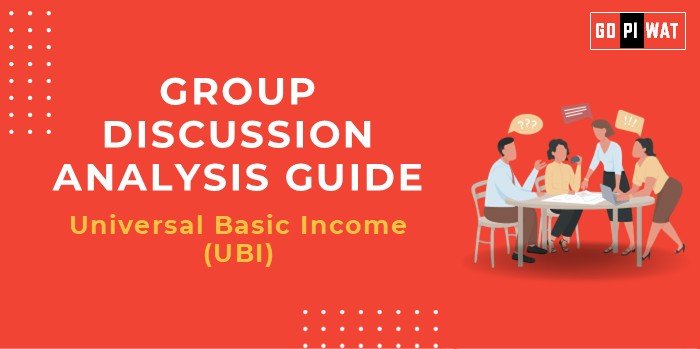📋 Group Discussion (GD) Analysis Guide: Universal Basic Income (UBI)
🌐 Introduction to the Topic
- 📌 Context Setting: Universal Basic Income (UBI) has emerged as a policy framework aiming to ensure a basic standard of living for all citizens. Particularly in developing nations, the concept has garnered attention for its potential to reduce poverty and address income inequality.
- 📌 Background: Rooted in economic theories from as early as the 16th century, UBI gained traction with recent pilots in Finland, Kenya, and India. Advocates suggest it simplifies welfare systems, while critics question affordability and societal impact.
📊 Quick Facts and Key Statistics
- 🌍 Global Poverty: As of 2023, approximately 700 million people live on less than $1.90 per day.
- 🇰🇪 UBI Pilot in Kenya: In 2018, GiveDirectly initiated one of the world’s largest UBI trials involving 20,000 participants across 200 rural villages. Early findings indicated improvements in housing, food security, mental health, and savings.
- 🇮🇳 UBI Pilot in India: The 2011 pilot by SEWA in Madhya Pradesh showed increased spending on food, healthcare, and education, leading to better health and higher school attendance rates.
- 💰 Fiscal Feasibility in India: Implementing UBI in India could cost between 4% to 5% of the country’s GDP annually.
🤝 Stakeholders and Their Roles
- 🏛️ Government: Policy formulation, funding allocation, and overseeing implementation.
- 🌐 Non-Governmental Organizations (NGOs): Conduct pilot programs, provide research, and offer insights into feasibility and impact.
- 👥 Citizens: Beneficiaries of UBI; their feedback and adaptation are crucial for assessing the program’s effectiveness.
- 📊 International Organizations: Provide financial support, research, and comparative analyses to guide policy decisions.
🏆 Achievements and ⚠️ Challenges
Achievements
- 💡 Poverty Reduction: UBI pilots in Kenya demonstrated reductions in poverty levels and improvements in quality of life.
- 📈 Economic Empowerment: Recipients often invest in small businesses or education, leading to long-term economic benefits.
- ⚙️ Simplification of Welfare Systems: UBI can streamline existing welfare programs, reducing administrative costs and corruption.
Challenges
- 💸 Fiscal Sustainability: High costs of implementation raise concerns about long-term viability, especially in economies with limited tax revenues.
- 📉 Inflationary Pressures: Increased cash influx without a corresponding rise in goods and services can lead to inflation.
- ⚖️ Work Disincentives: There is concern that guaranteed income might reduce the incentive to work, affecting labor markets.
🌍 Global Comparisons
- 🇫🇮 Finland: A pilot (2017-2018) providing €560 monthly to 2,000 unemployed individuals found improved well-being but no significant effect on employment levels.
- 🇮🇷 Iran: A nationwide cash transfer program launched in 2011 provided $45 monthly per person, replacing energy subsidies and aiming to reduce poverty.
📖 Case Studies
- 🇰🇪 Kenya: GiveDirectly’s ongoing UBI experiment showed positive impacts on recipients’ well-being, including improved mental health and increased economic activity.
- 🇮🇳 India: SEWA’s pilot in Madhya Pradesh demonstrated better health and education outcomes, with recipients spending more on nutritious food and schooling.
💡 Structured Arguments for Discussion
- Supporting Stance: “UBI has the potential to eradicate extreme poverty and empower individuals by providing financial security, leading to improved health, education, and economic outcomes.”
- Opposing Stance: “Implementing UBI in developing nations is fiscally unsustainable and may lead to inflation and reduced labor market participation, ultimately harming the economy.”
- Balanced Perspective: “While UBI offers promising benefits in poverty alleviation and economic empowerment, its implementation in developing countries requires careful consideration of fiscal constraints, potential inflationary effects, and cultural contexts.”
🗣️ Effective Discussion Approaches
- 📊 Opening Approaches:
- “With over 700 million people living on less than $1.90 a day, UBI presents a potential solution to global poverty.”
- “Kenya’s UBI pilot involving 20,000 participants has shown promising results in improving quality of life and economic activity.”
- 📌 Counter-Argument Handling:
- “Acknowledge fiscal concerns but suggest phased implementation and alternative funding mechanisms, such as reallocating existing subsidies or introducing progressive taxation.”
- “Address work disincentive arguments by referencing studies indicating minimal impact on labor participation rates.”
📈 Strategic Analysis: SWOT
- Strengths:
- Direct poverty alleviation.
- Simplification of welfare systems.
- Economic empowerment and increased consumer spending.
- Weaknesses:
- High implementation costs.
- Potential inflationary effects.
- Risk of reduced labor market participation.
- Opportunities:
- Technological advancements enabling efficient distribution.
- Potential to reduce income inequality.
- Encouragement of entrepreneurship and innovation.
- Threats:
- Political resistance and public skepticism.
- Mismanagement or corruption in fund distribution.
- Economic instability due to improper implementation.
🎓 Connecting with B-School Applications
- 🌍 Real-World Applications:
- Analysis of UBI’s impact on economic development, social welfare policies, and labor markets.
- Exploration of funding mechanisms and fiscal policies to support UBI.
- 📚 Sample Interview Questions:
- “How can UBI be integrated into existing social welfare systems in developing countries?”
- “What are the potential economic impacts of UBI on labor markets in emerging economies?”
- 💡 Insights for B-School Students:
- Understanding the complexities of policy implementation in diverse economic contexts.
- Evaluating the role of innovative financial solutions in addressing social challenges.
- Analyzing the interplay between social policies and economic outcomes.


